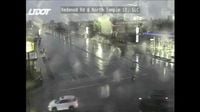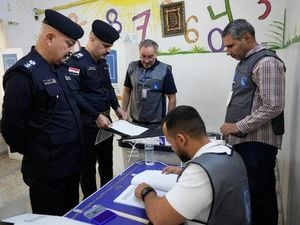Saturday night in Salt Lake City was anything but ordinary for sports fans, concertgoers, and thousands of residents as severe weather swept across northern Utah, disrupting major events and causing widespread power outages. The highly anticipated Arizona State versus Utah football game, scheduled for prime time at Rice-Eccles Stadium, became a lightning rod—literally—for the evening’s drama, as a powerful storm rolled through the Salt Lake and Utah Valleys, forcing organizers and locals alike to scramble for shelter and safety.
The National Weather Service had its eyes on the region early in the evening, issuing a high wind warning for Utah Valley that was soon extended to the Salt Lake Valley as the storm intensified. According to the department’s Salt Lake City office, wind gusts exceeding 60 miles per hour were possible, raising alarms for outdoor events and those traveling in the area. The warning remained in effect through 9 p.m., setting the stage for a tense and unpredictable night. As the storm’s grip tightened, the Redwest Country Music Festival—another major event in Salt Lake City—was forced to close and evacuate, sending disappointed fans home and underscoring the seriousness of the weather threat, as reported by KSL TV.
But it was the showdown between Arizona State University (ASU) and the University of Utah that drew the most attention. The game, slated for a 7:15 p.m. kickoff, was delayed by 10 minutes due to a lightning threat that forced both teams to halt their pregame warmups. According to Utah Athletics, the official kickoff didn’t occur until 7:25 p.m., as stadium officials and weather monitors worked in tandem to ensure player and spectator safety. The delay, while brief, added an extra layer of anticipation to a matchup already loaded with Big 12 implications—both ASU and Utah are contenders fighting for a coveted spot in the conference title game.
Fans in and around Rice-Eccles Stadium were urged to seek shelter as the storm approached. "Fans are encouraged to stay where you are and seek shelter. Text UTAH to 78015 for updates," Utah Athletics advised, emphasizing the importance of safety over sport. For those outside the stadium but holding tickets, the message was clear: get inside and take refuge on the concourse, or return to your vehicles until the worst passed. The school announced just before 8 p.m. that the lightning threat had subsided, and it was safe for fans to return to their seats, a welcome relief for those eager to watch the Sun Devils and Utes clash under the stadium lights.
The weather’s impact wasn’t limited to Salt Lake City. In Arizona, storms also delayed the Arizona-BYU game, which had started at 5 p.m. MST but was interrupted by a weather delay around 5:50 p.m. before the second quarter could get underway. According to Arizona Sports, it was a night of interruptions across the region, as Mother Nature reminded everyone of her unpredictable power.
On the field in Salt Lake City, the Sun Devils had to make a last-minute adjustment: backup quarterback Jeff Sims started in place of the injured Sam Leavitt, a change that could have significant implications for ASU’s push toward the Big 12 title game. The team faces league frontrunner Texas Tech the following week, making every play and every point in Salt Lake City even more crucial for their postseason hopes.
While the football drama unfolded, thousands of Utah residents found themselves in the dark—literally. The storm’s high winds and lightning resulted in widespread power outages along the Wasatch Front, affecting communities from Salt Lake City and Millcreek to Ogden and American Fork. According to Rocky Mountain Power, approximately 5,352 customers in Salt Lake City and surrounding areas lost power, part of a total of nearly 5,900 outages across the region. The utility company quickly dispatched crews to investigate and repair damaged facilities, with spokesperson Jona Whitesides noting that crews were on standby to address weather-related concerns throughout the evening.
Rocky Mountain Power kept residents updated as repairs progressed, restoring power to 2,905 customers within a few hours. The company issued a safety reminder: "We are working to make repairs to our facilities and restore your services as soon as possible. As a safety reminder, please treat all downed wires as live and dangerous." Their message, echoed in a Facebook post, underscored the hazards that can accompany severe weather, especially when downed power lines are involved.
The impact of the storm was felt not just in stadiums and homes, but on city streets and highways as well. Traffic cameras operated by the Utah Department of Transportation captured images of the severe weather near the Salt Lake City Fairgrounds, where visibility was low and conditions treacherous. The National Weather Service’s decision to expand the high wind warning to include Salt Lake Valley proved prescient, as gusts battered the area and emergency crews braced for calls.
For many, the evening’s events were a stark reminder of how quickly plans can change. What began as a typical Saturday night—filled with football, music, and the promise of autumn festivities—was transformed by the raw force of nature. The Redwest Country Music Festival’s closure and evacuation left concertgoers disappointed but safe, while sports fans experienced the tension of weather delays and the relief of an eventual return to normalcy.
Throughout the ordeal, local media and authorities worked to keep the public informed. Updates flowed from Utah Athletics, Rocky Mountain Power, and the National Weather Service, ensuring that residents, fans, and event organizers had the information they needed to stay safe and adapt to changing circumstances. According to ABC4, the story was still unfolding late Saturday night, with crews continuing their efforts to restore power and monitor lingering weather threats.
As the storm clouds finally began to lift, Salt Lake City and its neighbors were left to reflect on a night of unexpected challenges and community resilience. For the Sun Devils and Utes, the delayed kickoff was just another hurdle in a season defined by high stakes and tough competition. For the thousands affected by power outages, it was a reminder of the importance of preparation and patience in the face of unpredictable weather. And for everyone who watched the skies and listened for updates, it was a night they won’t soon forget.
Sometimes, the most memorable moments aren’t found in the final score or the encore performance, but in the shared experience of weathering the storm—together.




